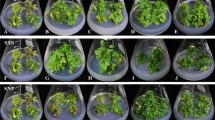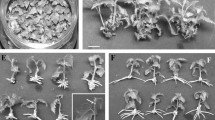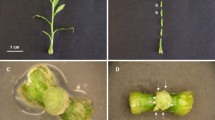Abstract
Initiation and elongation of lateral buds is stimulated in in vitro-grown shoots of Hancornia speciosa(a tropical fruit tree) by high temperature (35 °C), which is associated with the plant's reduced ability to release ethylene. However, no increase in either lateral shoot elongation or multiplication rate of H. speciosa shoots growing in vitro at non-shoot inducing temperature (31 °C) was associated with the presence of inhibitors of ethylene biosynthesis, such as α-amino isobutyric acid and cobalt ions or (aminooxy) acetic acid. Likewise, no increase in the multiplication rate was associated with aminoethoxyvinylglycine (AVG), another inhibitor of ethylene biosynthesis. In addition, stimulation of lateral shoot elongation in H. speciosa shoots grown at non shoot-inducing temperature was achieved when two inhibitors of the ethylene signal transduction pathway, silver thiosulphate (5–10 μM Ag++) and 1-methylcyclopropene (90 nl l−1) were present in the culture medium or in the culture vessel-headspace, respectively. However, increased multiplication only occurred with the 1-methylcyclopropene-treated shoots. Thus, lateral bud development with 1-methylcyclopropene could be used to enhance H. speciosa multiplication in vitro.
Similar content being viewed by others
References
Armstrong J, Lemos EEP, Zobayed SMA, Justin SHFW & Armstrong W (1997) A humidity-induced convective through flow ventilation system benefits Annona squamosa L. explants and coconut calloid. Ann. Bot. 79: 31-40
Biddington NL (1992) The influence of ethylene in plant tissue culture. Pl. Growth Reg. 11: 173-187
Bleecker AB & Schaller GE (1996) The mechanism of ethylene perception. Plant Physiol. 111: 653-660
Gaspar T, Kevers C, Bouillenne H, Maziere Y & Barbe J-P (1989) Ethylene production in relation to rose micropropagation through axillary budding. In: Clijsters H et al. (eds) Biochemical and Physiological Aspects of Ethylene Production in Lower and Higher Plants (pp 303-312). Kluwer Academic Publishers, Dordrecht
George EF & Sherrington PD (1984) Plant Propagation by Tissue Culture. Handbook and Directory of Commercial Laboratories. Exegetics Ltd, Eversley
Hall WC, Aho HM, Berry AW, Cowan DS, Harpham NVJ, Holland MG, Moskov I Ye, Novikova G & Smith AR (1993) Ethylene receptors. In: Pech JC et al., (eds) Cellular and Molecular Aspects of the Plant Hormone Ethylene (pp 168-173). Kluwer Academic Publishers, Dordrecht
Kieber JJ (1997) The ethylene response pathway in arabidopsis. Annu. Rev. Plant Physiol. Mol. Biol. 48: 277-296
Karhu ST (1997a) Axillary shoot proliferation of blue honeysuckle. Plant Cell Tiss. Org. Cult. 48: 195-201
Karhu ST (1997b) Sugar use in relation to shoot induction by sorbitol and cytokinin in apple. J. Am. Soc. Hortic. Sci. 122: 476-480
Keller CP & Van Volkenburgh E (1997) Auxin-induced epinasty of tobacco leaf tissues. Plant Physiol. 113: 603-610
Lambardi M, Benelli C & Fabbri A (1997) In vitro axillary shoot proliferation of apple rootstocks under different ethylene conditions. In Vitro Cell. Dev. Biol.-Plant. 33: 70-74
Li-Chun J & Li CJ (1997) Role of ethylene in apical dominance of pea plants. Acta-Phytophysiol. Sinica 23: 283-287
Marino G, Berardi G & Ancherani M (1995) The effect of the type of closure on the gas composition of the headspace and the growth of GF 677 peach × almond rootstock cell suspension cultures. In Vitro Cell. Dev. Biol.-Plant 31: 207-210
Martin MN, Cohen JD & Saftner RA (1995) A new 1-aminocyclopropane-1-carboxylic acid-conjugating activity in tomato fruit. Plant Physiol. 109: 917-926
Matthys D, Gielis J & Debergh P (1995) Ethylene. In: Aitken-Christie J et al. (eds) Automation and Environmental Control in Plant Tissue Culture (pp 473-491). Kluwer Academic Publishers, Dordrecht
Mulkey TJ, Kuzmanoff KM & Evans ML (1982) Promotion of growth and hydrogen ion efflux by auxin in roots of maize pretreated with ethylene biosynthesis inhibitors. Plant Physiol. 70: 186-188
Murashige T & Skoog F (1962) A revised method for rapid growth and bioassays with tobacco tissue cultures. Physiol. Plant. 15: 473-497
Pereira-Netto AB & McCown BH (1999) Thermally induced changes in shoot morphology of Hancornia speciosa microcultures: evidence of mediation by ethylene. Tree Physiol. 19: 733-740
Saltveit-Jr ME & Larson RA (1983) Effect of mechanical stress and inhibitors of protein synthesis on leaf epinasty in mechanically stressed poinsettia plants. J. Amer. Soc. Hort. Sci. 108: 253-257
Shekhawat NS, Rathore T S, Singh RP, Deora NS & Rao SR (1993) Factors affecting in vitro clonal propagation of Prosopis cineraria. Pl. Growth Reg. 12: 273-280
Sisler EC (1991) Ethylene-binding components in plants. In:Mattoo AK & Suttle JC (eds.) The Plant Hormone Ethylene (pp. 81-99). CRC Press, Boca Raton
Sisler EC, Dupille E & Serek M (1996a)Effect of 1-methylcyclopropene and methylenecyclopropane on ethylene binding and ethylene action on cut carnations. Plant Growth Regul. 18: 79-86
Sisler EC, Serek M & Dupille E (1996b) Comparison of cyclopropene, 1-methylcyclopropene and 3,3-dimethylcyclopropene as ethylene antagonists in plants. Plant Growth Regul. 18: 169-174
Sisler EC & Serek M (1997) Inhibitors of ethylene responses in plants at the receptor level: Recent developments. Physiol. Plant. 100: 577-582
Veen H & Overbeek JHM (1989) The action of silver thiosulphate in carnation petals. In: Clijsters H et al. (eds) Biochemical and Physiological Aspects of Ethylene Production in Lower and Higher Plants (pp 109-117). Kluwer Academic Publishers, Dordrecht
Vioque B & Castellano JM(1994) Extraction and biochemical characterization of 1-aminocyclopropane-1-carboxylic acid oxidase from pear. Physiol. Plant. 90: 334-338
Woltering EJ, Somhorst D & Van Der Veer P (1995) The role of ethylene in interorgan signaling during flower senescence. Plant Physiol. 109: 1219-1225
Yang SF & Hoffman NE (1984) Ethylene biosynthesis and its regulation in higher plants. Ann. Rev. Plant Physiol. 35: 155-189
Yu Y-B, Adams DO & Yang SF (1980) Inhibition of ethylene production by 2,4-dinitrophenol and high temperature. Plant Physiol. 66: 286-290
Author information
Authors and Affiliations
Rights and permissions
About this article
Cite this article
Pereira-Netto, A.B. Effect of inhibitors of ethylene biosynthesis and signal transduction pathway on the multiplication of in vitro-grown Hancornia speciosa. Plant Cell, Tissue and Organ Culture 66, 1–7 (2001). https://doi.org/10.1023/A:1010699922346
Issue Date:
DOI: https://doi.org/10.1023/A:1010699922346




